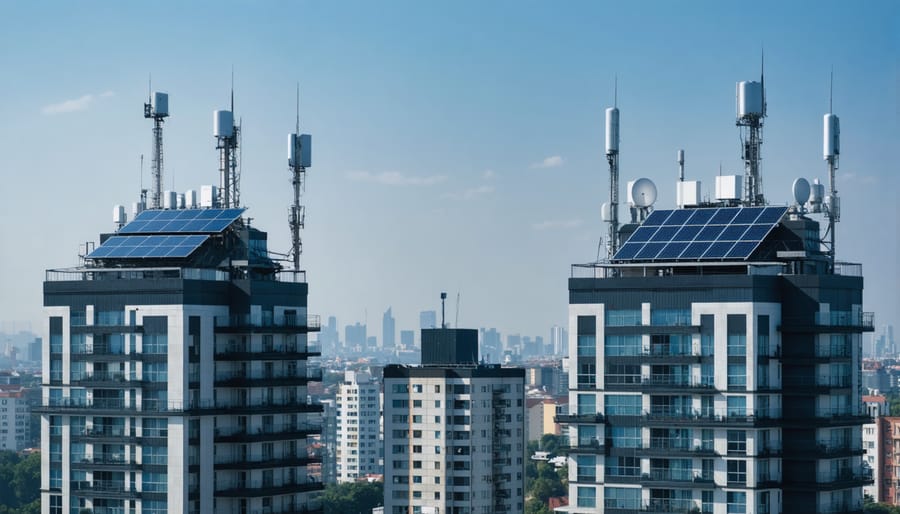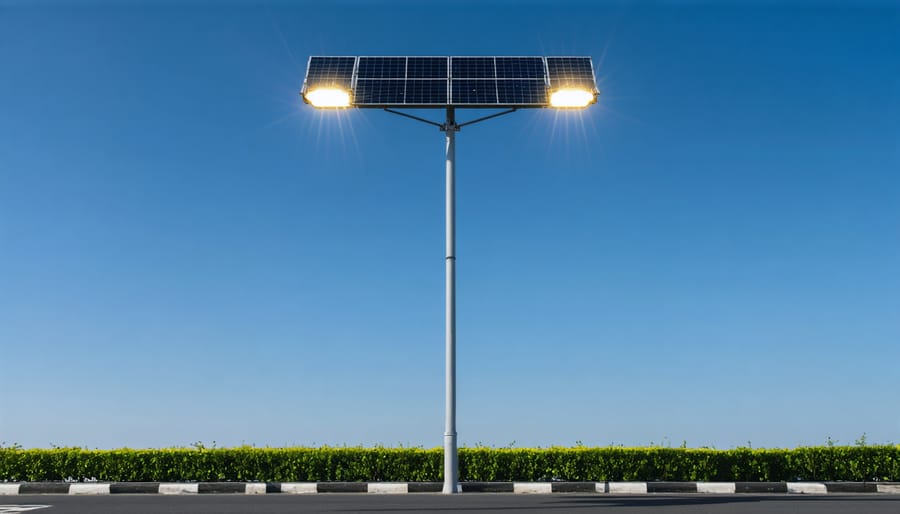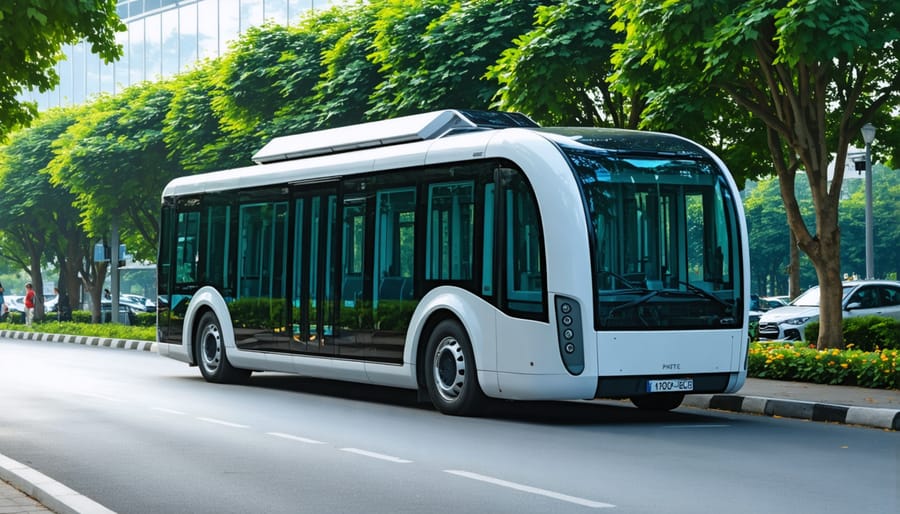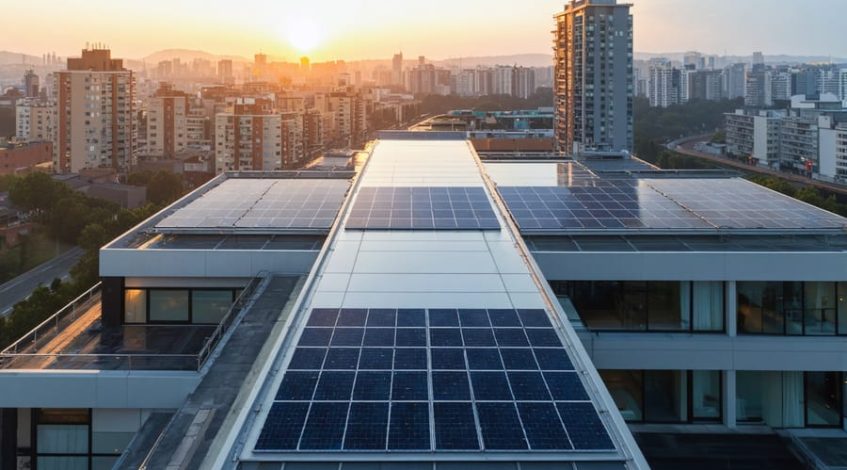The convergence of 5G technology and solar-powered smart cities represents a transformative leap in urban infrastructure development, delivering unprecedented connectivity, efficiency, and sustainability. This revolutionary integration enables real-time data processing, automated grid management, and intelligent resource allocation across city systems – from traffic control to energy distribution. With ultra-low latency communications and massive device connectivity, 5G networks serve as the nervous system of modern urban environments, while sustainable energy solutions power this digital transformation. Leading municipalities worldwide are already leveraging this powerful combination to reduce operational costs by up to 30% while dramatically improving public services and quality of life. The fusion of 5G and smart city technologies isn’t just an infrastructure upgrade – it’s a strategic imperative for urban centers aiming to thrive in an increasingly connected and sustainable future.

The Symbiotic Relationship Between 5G and Solar Infrastructure
Powering 5G Base Stations with Solar Energy
Solar energy solutions are emerging as a vital component in powering 5G base stations, addressing both sustainability goals and operational challenges. These base stations, which require 2-3 times more power than their 4G predecessors, benefit from hybrid solar systems that combine photovoltaic panels with energy storage solutions.
Leading telecommunications providers have successfully implemented solar-powered 5G stations in various urban environments. For example, Deutsche Telekom’s pilot program in Germany demonstrated a 20% reduction in grid dependency through integrated solar installations. Similarly, Vodafone’s implementation in the UK achieved up to 30% energy cost savings while ensuring reliable network performance.
The integration process typically involves installing high-efficiency solar panels directly on or adjacent to base stations, coupled with smart energy management systems. These systems optimize power distribution based on network demand patterns and available sunlight. Advanced battery storage solutions ensure continuous operation during non-peak solar hours, maintaining network reliability.
Key benefits include reduced operational costs, enhanced grid independence, and lower carbon emissions. Industry analysis suggests that solar-powered 5G base stations can achieve ROI within 4-6 years, making them an increasingly attractive option for smart city infrastructure development.
Energy Management Through 5G Networks
The integration of 5G networks with energy management systems is revolutionizing how cities monitor and optimize their power consumption. Through ultra-low latency and high-bandwidth connections, advanced solar monitoring systems can now process and analyze energy data in real-time, enabling precise control over power distribution and storage.
Smart cities are leveraging 5G technology to create responsive energy grids that automatically adjust to changing demands and environmental conditions. These systems can instantly detect fluctuations in solar panel performance, predict maintenance needs, and optimize energy storage based on usage patterns and weather forecasts.
The millisecond responsiveness of 5G networks allows for immediate load balancing and power redistribution, reducing waste and ensuring reliable energy supply during peak demands. Cities implementing these solutions have reported up to 30% improvement in solar energy efficiency and significant reductions in operational costs.
For facility managers and urban planners, this means enhanced visibility into energy consumption patterns and the ability to make data-driven decisions about resource allocation. The combination of 5G and smart energy management creates a more resilient and sustainable urban infrastructure while delivering measurable returns on investment.
Smart City Applications and Benefits
Intelligent Street Lighting Systems
Intelligent street lighting systems represent a cornerstone of 5G-enabled smart cities, combining advanced LED technology with solar power and sophisticated connectivity. These systems utilize photovoltaic panels to harness solar energy during daylight hours, storing excess power in high-capacity batteries for nighttime operation. Through 5G networks, each light pole becomes a smart node capable of real-time monitoring and adaptive control.
The integration enables dynamic illumination based on ambient light conditions, pedestrian presence, and traffic patterns. Motion sensors and environmental monitoring devices connected via 5G networks allow for instantaneous adjustments, reducing energy consumption by up to 80% compared to traditional lighting systems. During low-traffic periods, lights automatically dim to conserve energy, brightening immediately when movement is detected.
These smart lighting solutions also serve as multi-functional infrastructure hubs, hosting 5G small cells, environmental sensors, and public Wi-Fi access points. Cities like Barcelona and Singapore have demonstrated successful implementations, achieving significant cost savings while enhancing public safety and environmental sustainability. The collected data supports predictive maintenance, optimizes energy distribution, and contributes to broader smart city initiatives, making intelligent street lighting a critical component of modern urban infrastructure.

Smart Grid Management
5G technology is revolutionizing how smart cities manage and optimize their power distribution networks. Through advanced smart grid integration, 5G enables real-time monitoring and control of energy resources with unprecedented precision.
The ultra-low latency and high bandwidth of 5G networks allow for millisecond-level response times in grid management, essential for maintaining stability when integrating renewable energy sources. Smart meters and IoT sensors can communicate instantaneously, enabling dynamic load balancing and automated demand response systems.
In practical applications, 5G-enabled grid management has demonstrated up to 30% improvement in energy distribution efficiency. Cities like Barcelona and Singapore have implemented these systems to reduce power outages by 45% and optimize solar energy utilization during peak demand periods.
The technology enables predictive maintenance through AI-powered analytics, identifying potential grid issues before they cause disruptions. This proactive approach has helped utilities reduce maintenance costs by up to 20% while improving grid reliability.
For facility managers and urban planners, 5G smart grid systems provide detailed consumption data and automated optimization tools, leading to more informed decision-making and improved energy resource allocation across city infrastructure.
Urban Mobility Solutions
Solar-powered 5G infrastructure is revolutionizing urban mobility through intelligent transportation systems and real-time traffic management. Smart traffic signals equipped with 5G sensors and powered by solar energy automatically adjust timing based on traffic flow, reducing congestion and emissions by up to 25%. These systems utilize AI algorithms to predict traffic patterns and optimize route planning across city networks.
Connected vehicle infrastructure, supported by solar-powered 5G nodes, enables vehicle-to-everything (V2X) communication, enhancing road safety and efficiency. Real-time data exchange between vehicles, pedestrians, and infrastructure helps prevent accidents and streamlines emergency response times.
Solar-powered smart parking solutions integrated with 5G connectivity guide drivers directly to available spaces, reducing time spent searching and decreasing urban congestion. These systems utilize occupancy sensors and mobile apps to provide real-time parking availability information.
Public transportation benefits from solar-powered 5G technology through precise tracking and dynamic scheduling. Smart bus stops equipped with solar panels power digital displays showing real-time arrival information and interactive route planning. Fleet management systems utilize 5G connectivity to optimize routes based on passenger demand and traffic conditions, improving service reliability while reducing operational costs.
The integration of solar power ensures these mobility solutions remain operational during power outages and contribute to cities’ sustainability goals.

Implementation Strategies and ROI
Cost-Benefit Analysis
Implementing 5G infrastructure in smart cities requires substantial initial investment, but the long-term benefits often justify the costs. Initial infrastructure expenses typically range from $5 million to $50 million for mid-sized cities, varying based on population density and existing infrastructure. However, studies indicate potential cost savings of 15-25% in urban operations over five years.
The primary cost components include network equipment, fiber optic cables, small cell installations, and system integration. Cities can expect to invest $20,000-30,000 per small cell node, with larger metropolitan areas requiring hundreds of nodes for comprehensive coverage. However, shared infrastructure models with telecom providers can reduce municipal costs by 30-40%.
ROI calculations demonstrate promising returns through multiple revenue streams. Smart lighting systems alone can reduce energy costs by 50-70%, while intelligent traffic management can decrease congestion-related expenses by 20%. Smart waste management systems show potential savings of 30% in operational costs.
Public-private partnerships have emerged as a viable financing model, with telecom companies often willing to share infrastructure costs in exchange for access rights. Additionally, federal grants and smart city initiatives can offset 20-40% of initial investments.
Cities implementing 5G-enabled solutions report breaking even within 3-5 years, with cumulative benefits exceeding costs by year 4. The most successful implementations demonstrate ROI rates of 25-35% when factoring in improved service delivery, reduced maintenance costs, and new revenue opportunities from data monetization.
Best Practices for Integration
Successful integration of 5G and smart city infrastructure requires careful planning and adherence to key technical guidelines. First, establish a comprehensive site assessment to identify optimal locations for both 5G small cells and solar installations, ensuring minimal interference between systems while maximizing coverage and energy generation.
Implement advanced power management systems that can handle the variable energy demands of 5G networks. These systems should incorporate energy storage solutions capable of managing peak loads and maintaining network reliability during periods of low solar generation.
Deploy smart monitoring systems that utilize IoT sensors to track both power consumption and network performance in real-time. This data enables predictive maintenance and optimal resource allocation across the integrated infrastructure.
Consider electromagnetic compatibility (EMC) requirements when designing the layout. Maintain appropriate distances between solar inverters and 5G equipment to prevent signal interference. Use shielded cables and proper grounding techniques to minimize electromagnetic disturbances.
Implement redundancy measures through hybrid power systems that combine solar with grid power, ensuring continuous operation of critical 5G infrastructure. Design scalable solutions that can accommodate future expansion of both network capacity and power requirements.
Finally, establish clear maintenance protocols that address both solar and 5G components while ensuring compliance with relevant safety standards and regulations. Regular system audits and performance optimization should be scheduled to maintain peak efficiency of the integrated infrastructure.
Case Study: European Smart City Success Story
Barcelona stands as a shining example of successful 5G smart city implementation in Europe, particularly through its innovative solar-powered infrastructure integration. The city’s Smart City Initiative, launched in 2019, demonstrates how renewable energy can power advanced telecommunications networks while supporting sustainable urban development.
The project began with the installation of solar-powered 5G small cells across the city’s 22 districts, strategically placed to maximize both sun exposure and network coverage. These installations now power approximately 60% of Barcelona’s 5G infrastructure, resulting in a 45% reduction in grid electricity consumption compared to traditional implementations.
Key achievements of Barcelona’s smart city transformation include:
– Integration of 2,500 solar-powered IoT sensors monitoring air quality, traffic flow, and waste management
– Implementation of smart lighting systems reducing energy consumption by 35%
– Development of a sustainable mobility network supporting 1,500 electric vehicles
– Creation of 200 smart bus stops with real-time information powered by solar energy
The financial impact has been equally impressive. The city reported annual energy cost savings of €3.5 million after full implementation, with an initial investment recovery period of just 4.5 years. The solar-powered 5G infrastructure has also proven remarkably resilient, maintaining 99.9% uptime even during adverse weather conditions.
Barcelona’s success has relied heavily on public-private partnerships, particularly collaboration between local utilities, technology providers, and municipal authorities. The city’s approach to data management has also been exemplary, with a central operations center processing over 500 million data points daily to optimize city services and energy usage.
The environmental impact has been significant, with the solar-powered 5G network contributing to a reduction of 12,000 metric tons of CO2 emissions annually. The project has also created over 300 new jobs in renewable energy and smart city technologies.
Perhaps most importantly, citizen satisfaction has increased by 35% since the project’s inception, with particular appreciation for improved public services and environmental initiatives. The success has led to Barcelona becoming a model for other European cities, with delegations from over 50 municipalities visiting to study the implementation.
This case study demonstrates that solar-powered 5G infrastructure is not just environmentally responsible but also economically viable and technically feasible for large-scale urban deployment.
The integration of 5G technology and smart city infrastructure represents a transformative shift in urban development, with significant implications for the future of sustainable energy management. As cities worldwide continue to embrace these technologies, we can expect to see increasingly sophisticated applications of IoT sensors, real-time data analytics, and automated systems working in harmony to optimize energy consumption and improve quality of life.
The successful implementation of 5G smart cities relies heavily on the convergence of multiple technologies and stakeholder collaboration. Business leaders and government officials must work together to develop comprehensive strategies that address infrastructure needs, data security, and sustainable energy integration. The demonstrated success of early adopters has shown that investment in smart city technologies can deliver substantial returns through reduced operational costs, improved resource management, and enhanced citizen services.
Looking ahead, the evolution of 5G smart cities will likely accelerate as technology continues to advance and become more cost-effective. Key success factors will include establishing robust public-private partnerships, maintaining strong cybersecurity measures, and ensuring scalable infrastructure deployment. Organizations that take proactive steps to integrate these technologies today will be better positioned to compete in the increasingly connected urban environments of tomorrow.
As we move forward, the focus must remain on creating sustainable, resilient, and citizen-centric smart cities that leverage 5G technology to maximize energy efficiency and environmental stewardship while delivering tangible benefits to residents and businesses alike.

